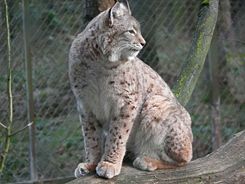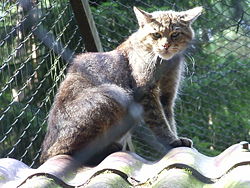Felidae
| Felids[1] Fossil range: 25–0 Ma Late Oligocene to Recent |
||||||||||||
|---|---|---|---|---|---|---|---|---|---|---|---|---|
Tiger (Panthera tigris)
|
||||||||||||
| Scientific classification | ||||||||||||
|
||||||||||||
| Subfamilies | ||||||||||||
|
Felinae |
Felidae is the biological family of the cats; a member of this family is called a felid. Felids are the most strictly carnivorous of the sixteen mammal families in the order Carnivora. The most familiar felid is the Domestic Cat, which first became associated with humans about 10,000 years ago, but the family includes all other wild cats including the big cats.
Extant felids belong to one of two subfamilies: Pantherinae (which includes the Lion, the Tiger, the Jaguar, and the Leopard), and Felinae (which includes the Cougar, the Cheetah, lynxes and the Caracal, along with the Domestic Cat).
The first felids emerged during the Oligocene, about 25 million years ago. In prehistoric times, there was a third subfamily Machairodontinae, which included the "saber-toothed cats" such as the well known Smilodon. There were also other cat-like mammals, such as Thylacosmilus or the Nimravidae which are not included in Felidae despite superficial similarities.
Contents |
Evolution
There are 40 known species of felids in the world today which have all descended from a common ancestor about 10.8 million years ago.[1] This taxon originated in Asia and spread across continents by crossing land bridges. As reported in the journal Science, testing of mitochondrial and nuclear DNA by Warren Johnson and Stephen O'Brien of the U.S. National Cancer Institute demonstrated that ancient cats evolved into eight main lineages that diverged in the course of at least 10 migrations (in both directions) from continent to continent via the Bering land bridge and Isthmus of Panama. The Panthera species are the oldest and the Felis species are the youngest. They estimated that 60 percent of the modern species of cats developed within the last million years.[3] Most felids have a haploid number of 18 or 19. New World cats (those in Central and South America) have a haploid number of 18, possibly due to the combination of two smaller chromosomes into one larger chromosome.[4]
Prior to this discovery, biologists had been largely unable to establish a family tree of cats from the fossil record because the fossils of different cat species all look very much alike, differing primarily in size.
The felids' closest relatives are thought to be the civets, hyenas, and mongooses. All felid species share a genetic anomaly that prevents them from tasting sweetness.[5]
Characteristics
Felids are purely carnivorous animals, subsisting almost entirely on other vertebrates. Aside from the Lion, they are solitary. Most are secretive animals, often nocturnal, and live in relatively inaccessible habitats. Around three-quarters of cat species live in forested terrain, and they are generally agile climbers. However, felids may be found in almost any environment, with some species being native to mountainous terrain or deserts.
Wild felids are native to every continent except Australia and Antarctica.
Physical appearance

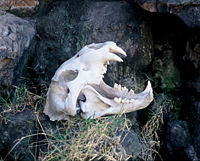
The various species of felid vary greatly in size. One of the smallest is the Black-footed Cat at between 35-40 cm in length, while the largest is the Siberian Tiger. Compared with many other mammals, they have relatively short faces, and good binocular vision.
The fur of felids takes many different forms, being much thicker in those species that live in cold environments, such as the Snow Leopard. The colour of felids is also highly variable, although brown to golden fur is common in most species, often marked with distinctive spots, stripes, or rosettes. Many species also have a "tear stripe," a black stripe running from the corner of each eye down the side of the muzzle.
The tongue of felids is covered with horny papillae, which help to rasp meat from their prey. Almost all felids have fully retractable claws (one exception is the Cheetah). Cats have five toes on their forefeet and four on their hindfeet, reflecting their reliance on gripping and holding down their prey with their claws.
Senses
Felids have relatively large eyes, situated to provide binocular vision. Their night vision is especially good, due to the presence of a tapetum lucidum, which reflects light back inside the eyeball, and gives cat eyes their distinctive shine.
The ears of felids are also large, and in the smaller cats especially sensitive to high-frequency sounds. Felids have a highly developed sense of smell, although not to the degree seen in canids. This is further supplemented by the presence of a vomeronasal organ in the roof of the mouth, allowing the animal to "taste" the air. The use of this organ is associated with the Flehmen response, in which the upper lip is curled upwards.
Felids possess highly sensitive vibrissa (whiskers) set deep within the skin, and provide the cat with sensory information about the slightest air movement around it. For this reason they are very helpful for a nocturnal hunter. Most felids are able to land on their feet after a fall, an ability which relies on vision and the sense of balance acting together.
Dentition
With only a few exceptions, such as the lynx, felids have the dental formula:
| 3.1.3.1 |
| 3.1.2.1 |
The canine teeth are large, reaching exceptional size in the extinct saber-tooth species. The upper third premolar and lower molar are adapted as carnassial teeth, suited to tearing and cutting flesh.
The jaws of felids can only move vertically. This prevents them from being able to chew, but makes it easier for their powerful masseter jaw muscles to hold struggling prey.
Classification
Traditionally five subfamilies are distinguished, the Felinae, the Pantherinae, the Acinonychinae (Cheetahs) and the extinct Machairodontinae and Proailurinae.[2] However the Acinonychinae are probably invalid, as genetic evidence suggests that cheetahs and pumas are close relatives.
Extant species
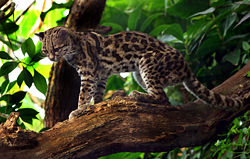
- FAMILY FELIDAE[1]
- Subfamily Felinae
- Genus Felis
- Chinese Mountain Cat (Felis bieti)
- Domestic Cat (Felis catus)
- Jungle Cat (Felis chaus)
- Pallas's Cat (Felis manul)
- Sand Cat (Felis margarita)
- Black-footed Cat (Felis nigripes)
- Wild Cat (Felis silvestris)
- Genus Prionailurus
- Leopard Cat (Prionailurus bengalensis)
- Iriomote Cat (Prionailurus iriomotensis)
- Flat-headed Cat (Prionailurus planiceps)
- Rusty-spotted Cat (Prionailurus rubiginosus)
- Fishing Cat (Prionailurus viverrinus)
- Genus Puma
- Genus Acinonyx
- Genus Lynx
- Canadian Lynx (Lynx canadensis)
- Eurasian Lynx (Lynx lynx)
- Iberian Lynx (Lynx pardinus)
- Bobcat (Lynx rufus)
- Genus Leopardus
- Pantanal Cat (Leopardus braccatus)
- Colocolo (Leopardus colocolo)
- Geoffroy's Cat (Leopardus geoffroyi)
- Kodkod (Leopardus guigna)
- Andean Mountain Cat (Leopardus jacobitus)
- Pampas Cat (Leopardus pajeros)
- Ocelot (Leopardus pardalis)
- Oncilla (Leopardus tigrinus)
- Margay (Leopardus wiedii)
- Genus Leptailurus
- Genus Caracal
- Genus Profelis
- African Golden Cat (Profelis aurata)
- Genus Catopuma
- Bay Cat (Catopuma badia)
- Asian Golden Cat (Catopuma temminckii)
- Genus Pardofelis
- Marbled Cat (Pardofelis marmorata)
- Genus Felis
- Subfamily Pantherinae
- Genus Neofelis
- Clouded Leopard (Neofelis nebulosa)
- Bornean Clouded Leopard (Neofelis diardi)
- Genus Panthera
- Genus Uncia
- Genus Neofelis
- Subfamily Felinae
Alternative classification
Genetic research gives a more concise classification for the living members of the cat family:[6][1][7]
- Lineage 1: Panthera, Uncia, Neofelis
- Lineage 2: Pardofelis, Catopuma,
- Lineage 3: Leptailurus, Caracal, Profelis
- Lineage 4: Leopardus
- Lineage 5: Lynx
- Lineage 6: Puma, Acinonyx
- Lineage 7: Prionailurus, Otocolobus
- Lineage 8: Felis
The last four lineages are more related to each other than to other lineages and form a clade within Felinae.
Fossil felids
The oldest known true felid (Proailurus) lived in the late Oligocene and early Miocene eras. During the Miocene it gave way to Pseudaelurus. Pseudaelurus is believed to be the latest common ancestor of the two extant subfamilies and the extinct subfamily, Machairodontinae. This group, better known as the sabertooth cats, became extinct in the Late Pleistocene era. It includes the genera Smilodon, Machairodus and Homotherium. The Metailurini have been placed originally as a distinct tribe within the Machairodontinae but count as members of the Felinae today.[8] Sometimes they are supposed to form a distinct subfamily Metailurinae.[9] The total number of fossil Felids that are known to science is not very high. Most extinct cat-like animals, once regarded as members of the Felidae, later turned out to be members of related, but distinct, families: the "false sabretooths" Nimravidae and Barbourofelidae. The true cats (Felidae) radiated quite recently and most of the extant species are relatively young.
Genera of the Felidae
The list follows McKenna and Bells Classification of Mammals for prehistoric genera (1997)[2] and Wozencraft (2005) in Wilson and Reeders Mammal Species of the World for extant genera.[1] Pseudaelurus is included here in the Felinae according to McKenna & Bell despite its basal position in felid evolution. Inconsistent to McKenna and Bell three additional prehistoric genera, Miracinonyx, Lokontailurus und Xenosmilus are listed, Sivapanthera is included into the Felinae (not Acinonychinae) and Ischrosmilus is included in the genus Smilodon.

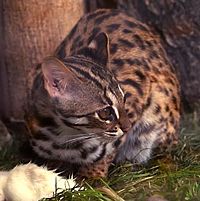
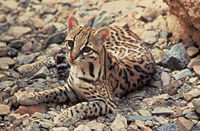

- †Proailurinae
- †Proailurus
- Felinae
- †Pseudaelurus
- †Sivaelurus
- †Vishnufelis
- †Pikermia
- †Abelia
- †Nimravides
- †Pratifelis
- †Adelphailurus
- †Metailurus
- †Dinofelis
- †Dolichofelis
- †Sivapardus
- †Jansofelis
- †Sivapanthera
- Acinonyx
- †Miracinonyx
- Puma
- Felis
- Prionailurus
- Lynx
- Leopardus
- Leptailurus
- Caracal
- Profelis
- Catopuma
- Pardofelis
- Pantherinae
- †Leontoceryx
- †Dromopanthera
- †Schaubia
- †Viretailurus
- Panthera
- Neofelis
- Uncia
- †Machairodontinae
- †Machairodus (Late Miocene, Africa, Eurasia, North America)
- †Homotherium (Pliocene, Pleistocene; Africa, Eurasia, North America)
- †Xenosmilus (Pleistocene; North America)
- †Lokontailurus (Latest Miocene; Africa)
- †Miomachairodus (Middle Miocene; Africa, Asia)
- †Hemimachairodus
- †Paramachairodus (Late Miocene; Eurasia, Africa)
- †Megantereon (Pliocene, Pleistocene; North America, Africa, Eurasia)
- †Smilodon (Late Pliocene to Late Pleistocene; North- and South America)
See also
- Felid hybrid
- Panthera hybrid
Cited references
- ↑ 1.0 1.1 1.2 1.3 1.4 Wozencraft, W. C. (16 November 2005). Wilson, D. E., and Reeder, D. M. (eds). ed.. Mammal Species of the World (3rd edition ed.). Johns Hopkins University Press. pp. 532-548. ISBN 0-801-88221-4. http://www.bucknell.edu/msw3.
- ↑ 2.0 2.1 2.2 McKenna, Malcolm C.; Susan K. Bell (2000-02-15). Classification of Mammals. Columbia University Press. pp. 631. ISBN 978-0231110136.
- ↑ Mott, Maryann (2006-01-11). "Cats Climb New family Tree". National Geographic News. Retrieved on 2006-07-15.
- ↑ Vella, Carolyn; et al. (2002). Robinson's Genetics for Cat Breeders and Veterinarians, 4th ed.. Oxford: Butterworh-Heinemann. ISBN 0-7506-4069-3.
- ↑ Xia, Li; Weihua Li, Hong Wang, Jie Cao, Kenji Maehashi, Liquan Huang, Alexander A. Bachmanov, Danielle R. Reed, Véronique Legrand-Defretin, Gary K. Beauchamp and Joseph G. Brand (July 2005). "Pseudogenization of a Sweet-Receptor Gene Accounts for Cats' Indifference toward Sugar". Public Library of Science 1 (1): e3. doi:. http://www.plosgenetics.org/article/info:doi/10.1371/journal.pgen.0010003. Retrieved on 2008-06-30.
- ↑ Johnson WE, Eizirik E, Pecon-Slattery J, et al (January 2006). "The late Miocene radiation of modern Felidae: a genetic assessment". Science (journal) 311 (5757): 73–7. doi:. PMID 16400146.
- ↑ O'Brien SJ, Johnson WE (2005). "Big cat genomics". Annu Rev Genomics Hum Genet 6: 407–29. doi:. PMID 16124868.
- ↑ van den Hoek Ostende, Lars W.; Michael Morlo and Doris Nagel (July 2006). Fossils explained 52 Majestic killers: the sabre-toothed cats. 22. pp. 150–157. http://www.ingentaconnect.com/content/bsc/gday/2006/00000022/00000004/art00006;jsessionid=pajs4k97owon.alexandra. Retrieved on 2008-06-30.
- ↑ Turner, Alan (1997-04-15). The Big Cats and their fossil relatives. New York: Columbia University Press. pp. 60. ISBN 978-0231102285.
General references
- Shoemaker, Alan (1996). "1996 Taxonomic and Legal Status of the Felidae". Felid Taxonomic Advisory Group of the American Zoo and Aquarium Association. Retrieved on 2006-07-15.
- Turner, A. (1997). The big cats and their fossil relatives. Columbia University Press. ISBN 0-231-10229-1.
- Kirby, G. (1984). "Cat family". in Macdonald, D.. The Encyclopedia of Mammals. Facts on File. ISBN 0-87196-871-1.
|
|||||||||||
|
||||||||||||||||||||||||||||||||||||||||||||||||||||||


